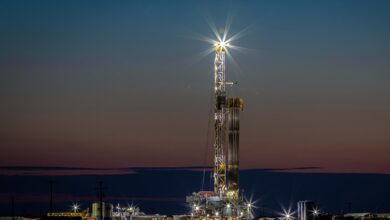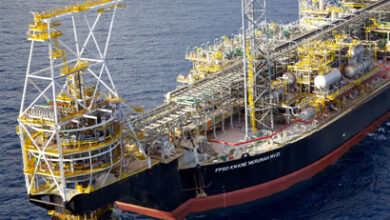Even amidst recovery, impact of oil price crash reverberates as investors press companies to increase returns by cutting costs
Personnel shortages also being felt at multiple skill levels, with many employees wary of returning to a cyclical industry
By Rick Von Flatern, Contributer

For nearly two years, the drilling industry has been in a painfully slow recovery mode, and prospects for 2019 appear to be more of the same.
In the latter half of 2014, average global oil prices went from a dizzying $100/bbl to just more than $50 by year’s end. By the start of 2017, oil prices had hit a low of about $20/bbl. In the ensuing two years, oil prices have trended up toward $70, where it remains today.
In the years leading up to the oil price crash, drilling contractors had invested billions of dollars in the construction of rigs capable of drilling in deepwater and ultra-deepwater. This was driven by the willingness of operators – who knew the return on their multibillion-dollar offshore investments were secured by $100 oil – to pay $500,000 dayrates for the latest-generation drillships.
The nearly unprecedented prices also spurred operators, service companies and contractors to swell their payrolls to 200,000, adding 40,000 workers in the years between 2010 and 2014, according to the US Bureau of Labor Statistics. Yet, by the end of 2017, the industry had released more than 50,000 employees.
Today, as prices recover and analysts predict at least a mild rise in activity, the effects of the 2014 price implosion still linger over the industry. The greatest impact on drilling contractors comes from a substantial oversupply of rigs that far outweighs any positive effects that might be realized from relatively high and steady oil prices.
“Too many rigs are warm-stacked or coming off contract that are older and need to come out of active supply,” said Leslie Cook, Principal Analyst at Wood Mackenzie. “We think upwards of another 50 rigs need to come out of active supply, but another 30 or so should come out over the next 12 to 16 months.”
Since September 2014, 85 jackups, 22 drillships and 95 semis have been retired, for a total of 202 offshore rigs, said Terry Childs, Head of RigLogix for Westwood Global RigLogix. “Despite the large number, there are still plenty of retirement candidates,” he said. “The cold-stacked fleet, where most attrition comes from, still includes 55 jackups, 18 drillships and 33 semis.”
The natural consequence of too many rigs chasing too little work is relatively low dayrates. But some contractors feel that a long-term, secure contract at lower prices is preferable to the costs of maintaining a stacked rig. For operators, the current rig oversupply is a chance to lock in future work at today’s low rates.
“Operators have been, in many cases, locking up rigs due to the low-rate environment,” Mr Childs said. “This will most definitely continue as 2018 ends and into 2019. However, there are a few areas where there are few or no rigs available, such as the US Gulf of Mexico jackups and Norway harsh-environment semis, and rates in those areas have risen in recent months.”
In contrast to rig oversupply, contractors and operators today face personnel shortages of every skill level. That is because many of the workers laid off in the most recent downturn are wary of returning to the cyclical oil industry and because many, particularly in shale-based plays that tend to be single-industry communities, have been forced to leave the area in search of other employment.
“We have seen from many operators that, for some companies, it is hard to rehire those laid off earlier, even with good incentives,” Alessandro Blasi, Senior Program Officer, Economics and Investment Office of the International Energy Agency, said about the Permian Basin. “There are labor shortages, not only in skilled positions like rig managers and completions engineers but also truck drivers and people working in logistics and infrastructure all around the Permian.”
The Cost of Money

The 2014 collapse of oil prices also changed how operators, investors and lenders view capital spending. While oil prices were trending skyward ahead of 2014 and seemed, to many observers, destined to remain high well into the future, investors encouraged operators to capture reserves and deliver returns through drilling.
In the wake of the crash, investors pressured operators to increase returns by cutting costs. This manifested most clearly in fewer and smaller capital expense projects, and investors are likely to continue to press operators to closely manage capital and operating expenses.
“Most companies that have announced higher-than-expected increases in capital spending have been penalized by the market in terms of stock performance,” Mr Blasi said. “The mood of the investor is to pay more attention to returns after many years of negative returns.”
Although market improvement is not uniform around the world, utilization and dayrates are gradually moving upward, particularly in certain key offshore markets.
“The US Gulf of Mexico jackup market and the North Sea/Norway harsh-environment semi markets will continue to be strong if rig owners do not oversupply the markets,” Mr Childs said. “Demand in the Middle East jackup market will also strengthen, and while rates in some parts of the region will rise, other contracts will continue to attract low rates.”
In a September 2018 press release, Norway-based Rystad Energy also reported a positive indicator for the offshore industry – a surge in final investment decisions (FIDs) on offshore oil and gas projects. Calling the FIDs a sure sign of a healthy increase in 2019 offshore investments, analysts attributed the sudden rise in the number of FIDs to a 50% year-on-year rise in the number of offshore projects that were sanctioned in 2017, with 62 FIDs.
This was followed by similar growth in 2018, with close to 100 offshore projects to be sanctioned. Based on the number of 2018 FIDs, offshore investment levels are forecast to rise for the first time following four years of contraction, according to the firm.
“Our offshore activity index is pointing to annual growth rates of about 6% toward 2022, thereby returning to the high activity levels seen in 2014,” said Audun Martinsen, Partner and Head of Oilfield Research at Rystad Energy. “Coupled with annual service price inflation of 5%, offshore oilfield service purchases are projected to grow by 11% per year toward 2022.”
Rystad Energy data show that global offshore capital investment fell by 16% in 2017 and is projected to fall by an additional 10% this year, reaching only about $160 billion. That would be less than half the $350 billion invested at the peak in 2014.
Shale Market
Despite investor insistence on better returns through cost cutting, shale companies will increase capital spending and, in fact, have been doing so recently, Mr Blasi said. “In futures results and investor presentations, what we have seen, compared to previous guidance the companies have issued, are increasing capital spending in the range of 5-10%, compared with January and February announcements.”
Mr Blasi said that operators’ willingness to spend more stems from a steadily, if slowly, rising oil price and cost inflation. In addition, he said, shale operators are now reaching a balance between growth and returning capital to investors.
In the first half of 2016, said Rystad Vice President for Shale Analysis Artem Abramov, drilling activity hit bottom because oil prices were below a normal threshold. “Then prices improved,” he said. “Some operators switched to full-scale development mode, and activity increased dramatically.”
Spending capital to drill and complete in shale plays continues to make economic sense but, until late 2019 or early 2020, is likely to be hindered by a lack of infrastructure, particularly in the Permian Basin, where pipelines are near capacity.
“Logistical challenges, takeaway capacity bottlenecks and growing oversupply in the proppant and fracking market are all contributing to pull shale’s growth trajectory downward,” Mr Martinsen said. Recently drilled in-basin sand mines in major shale plays, he added, have driven frac sand prices to below $40/ton.
The net effect of these factors will be a growth in shale investment levels at a slower pace than that previously expected, at about $120 billion in 2018, according to Mr Martinsen. Rystad forecasts approximately 22,000 shale wells will be drilled and completed in North America in 2019, which will translate to an approximately 16% growth in investments.
“Shale has, thus, lost some momentum at a time when investors have again found an appetite for the offshore domain, stimulated by a steep reduction in offshore costs and breakeven levels, which in turn have been driven by favorable unit prices,” Mr Martinsen added.
Independent shale operators have traditionally carried debt loads that include interest rates near 6%, nearly double the rate charged to major oil companies. But because they proved their ability to improve their financial condition, servicing that debt is not overly burdensome for these companies.
“A 6% interest rate is not small, especially if you compare with big players on the conventional size,” Mr Blasi said. “The (Federal Reserve) increased the cost of capital starting at the end of 2015. In spite of that, we are now seeing a downward trend in interest rates for shale operators. This is a clear sign that improvement of the financial condition of the shale companies matters more than general cost of capital.”
Of course, this picture applies to the shale sector as a whole and widely varies company by company. Overall, he said, he sees no sign that operators are being constrained in terms of access to money.
Wildcards
As the effects of the 2014 price collapse begin to recede, many drilling rig market analysts appear convinced that activity levels and dayrates will move modestly upward in 2019. Current demand growth promises to continue upward pressure on oil prices well into the future, and oil prices are moving in a positive direction as a result. Rig oversupply is declining as demand for their services also inches upward.
Most observers believe the bottlenecks in the Permian and elsewhere will be relieved in 2019, which will cause a surge in North American land drilling. Natural gas prices are also likely to get a boost in 2019 and beyond as demand rises for liquefied natural gas. Operators are also turning attention once again to deepwater plays, particularly in South and Central America and the US and Mexican Gulf of Mexico.
Perhaps the least understood driver going forward today is political. While much of Latin America sits atop large reserves of oil and gas and are relatively stable democracies, a few of the most important oil-producing nations are experiencing political turmoil. That is certain to have repercussions for their national oil companies and partners.
In October, for example, Brazil was in the midst of an acrimonious presidential election with candidates from either end of the political spectrum. And the economy of Venezuela has collapsed; its government is both dysfunctional and opposed by most of the country’s citizens.
In the US, the current administration in Washington, DC, has also created considerable uncertainty among developed nations by upending global trade agreements and threatening trade wars with traditional trading partners. These policies have the potential to test the strength of the worldwide economy, which is a key driver of increasing oil demand.
Tariffs imposed by the Trump administration on imported steel are already increasing costs for steel tubulars. To date, drilling contractors have been able to absorb those costs or pass them on with other rising operating costs. However, to a large degree, they are able to do so only by using tubulars purchased and placed in stock before tariffs were imposed.
Still, analysts seem unphased by such concerns and remain in broad agreement that the worst is over for the oil and gas industry. It now requires only patience as the industry recovers at a pace that seems glacial to operators and contractors alike. DC




